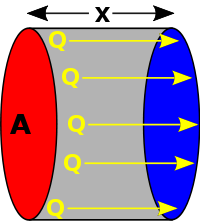Heat conduction
Heat conduction or thermal conduction is the spontaneous transfer of thermal energy through matter, from a region of higher temperature to a region of lower temperature, and hence acts to even out temperature differences.
The thermal energy, in the form of continuous random motion of the particles of the matter, is transferred by the same coulomb forces that act to support the structure of matter, so can be said to move by physical contact between the particles.
It should be noted that heat can also be transferred by radiation and/or convection, and often more than one of these processes occur in a particular situation.
The law of heat conduction, also known as Fourier's law, states that the time rate of heat transfer through a material is proportional to the negative gradient in the temperature and to the area at right angles, to that gradient, through which the heat is flowing:
where
- Q is the amount of heat transferred,
- t is the time taken,
- k is the material's conductivity. (this generally varies with temperature, but the variation can be small over a significant range of temperatures for some common materials.),
- S is the surface through which the heat is flowing,
- T is the temperature.
The above differential equation, when integrated for a simple linear situation (see diagram), where uniform temperature across equally sized end surfaces and perfectly insulated sides exist, gives the heat flow rate between the end surfaces as:
where
- A is the cross-sectional surface area,
- is the temperature difference between the ends,
- is the distance between the ends.
This law forms of the basis for the derivation of the heat equation. R-value is the unit for heat resistance, the reciprocal of the conductance. Ohm's law is the electrical analogue of Fourier's law.
Conductance
Writing
where U is the conductance.
Fourier's law can also be stated as:
The reciprocal of conductance is resistance, R, given by:
and it is resistance which is additive when several conducting layers lie between the hot and cool regions, because A and Q are the same for all layers. In a multilayer partition, the total conductance is related to the conductance of its layers by:
So, when dealing with a multilayer partition, the following formula is usually used:
When heat is being conducted from one fluid to another through a barrier, it is sometimes important to consider the conductance of the thin film of fluid which remains stationary next to the barrier. This thin film of fluid is difficult to quantify, its characteristics depending upon complex conditions of turbulence and viscosity, but when dealing with thin high-conductance barriers it can sometimes be quite significant.
Newton's law of cooling
A related principle, Newton's law of cooling, states that the rate of heat loss of a body is proportional to the difference in temperatures between the body and its surroundings. The law is
- Thermal energy transfer in Joules
- Heat transfer coefficient
- Surface area of the heat being transferred
- Temperature of the object's surface
- Temperature of the surroundings
This form of heat loss principle is sometimes not very precise; an accurate formulation may require analysis of heat flow, based on the (transient) heat transfer equation in a nonhomogeneous, or else poorly conductive, medium. The following simplification may be applied so long as it is permitted by the Biot number, which relates surface conductance to interior thermal conductivity in a body. If this ratio permits, it shows that the body has relatively high internal conductivity, such that (to good approximation) the entire body is at same uniform temperature as it is cooled from the outside, by the environment. If this is the case, then it is easy to derive from these conditions the behavior of exponential decay of temperature of a body. In such cases, the entire body is treated as lumped capacitance heat reservoir, with total heat content which is proportional to simple total heat capacity, and the temperature of the body. If T(t) is the temperature of such a body at time t, and Tenv is the temperature of the environment around the body, then
where
- r is a positive constant characteristic of the system, which must be in units of 1/time, and is therefore sometimes expressed in terms of a time constant: r = 1/t0.
The solution of this differential equation, by standard methods of integration and substitution of boundary conditions, gives:
Here, T(t) is the temperature at time t, and T(0) is the initial temperature at zero time, or t = 0.
If:
- is defined as : where is the initial temperature difference at time 0,
then the Newtonian solution is written as:
Uses: For example, simplified climate models may use Newtonian cooling instead of a full (and computationally expensive) radiation code to maintain atmospheric temperatures.
Fourier's law of conduction
where
- : heat flux vector [ J·m−2·s−1 ]
- T: temperature [ K ]
- : thermal conductivity tensor [ W·m−1·K−1 ]
See also
- Heat
- Thermal conductivity
- Heat transfer
- Convection
- Thermal radiation
- Thermal contact conductance
- Heat pipe
- Fick's law of diffusion
- Churchill-Bernstein Equation
Credits
New World Encyclopedia writers and editors rewrote and completed the Wikipedia article in accordance with New World Encyclopedia standards. This article abides by terms of the Creative Commons CC-by-sa 3.0 License (CC-by-sa), which may be used and disseminated with proper attribution. Credit is due under the terms of this license that can reference both the New World Encyclopedia contributors and the selfless volunteer contributors of the Wikimedia Foundation. To cite this article click here for a list of acceptable citing formats.The history of earlier contributions by wikipedians is accessible to researchers here:
The history of this article since it was imported to New World Encyclopedia:
Note: Some restrictions may apply to use of individual images which are separately licensed.
























